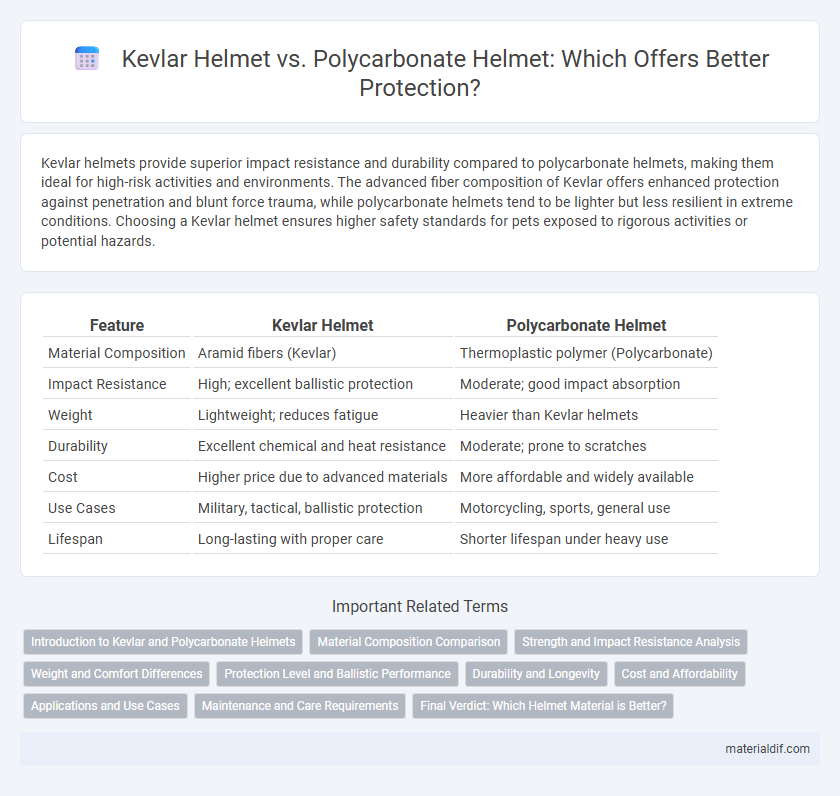Kevlar helmets provide superior impact resistance and durability compared to polycarbonate helmets, making them ideal for high-risk activities and environments. The advanced fiber composition of Kevlar offers enhanced protection against penetration and blunt force trauma, while polycarbonate helmets tend to be lighter but less resilient in extreme conditions. Choosing a Kevlar helmet ensures higher safety standards for pets exposed to rigorous activities or potential hazards.
Table of Comparison
| Feature | Kevlar Helmet | Polycarbonate Helmet |
|---|---|---|
| Material Composition | Aramid fibers (Kevlar) | Thermoplastic polymer (Polycarbonate) |
| Impact Resistance | High; excellent ballistic protection | Moderate; good impact absorption |
| Weight | Lightweight; reduces fatigue | Heavier than Kevlar helmets |
| Durability | Excellent chemical and heat resistance | Moderate; prone to scratches |
| Cost | Higher price due to advanced materials | More affordable and widely available |
| Use Cases | Military, tactical, ballistic protection | Motorcycling, sports, general use |
| Lifespan | Long-lasting with proper care | Shorter lifespan under heavy use |
Introduction to Kevlar and Polycarbonate Helmets
Kevlar helmets are constructed using synthetic aramid fibers known for their high tensile strength and exceptional impact resistance, making them ideal for ballistic protection. Polycarbonate helmets utilize a thermoplastic polymer that offers lightweight durability and effective protection against blunt impacts and penetration. Both materials serve critical roles in helmet manufacturing, with Kevlar excelling in bullet resistance and polycarbonate providing versatility and affordability.
Material Composition Comparison
Kevlar helmets are made from tightly woven aramid fibers known for exceptional tensile strength and thermal resistance, offering superior ballistic protection. Polycarbonate helmets consist of a thermoplastic polymer that is lightweight and impact-resistant but generally less effective against high-velocity projectiles. The unique molecular structure of Kevlar fibers provides enhanced durability and multi-hit capability compared to the more flexible, lower-density polycarbonate material.
Strength and Impact Resistance Analysis
Kevlar helmets exhibit superior strength and impact resistance due to their woven aramid fiber construction, which dissipates energy effectively upon impact. Polycarbonate helmets, made from thermoplastic polymers, provide moderate impact resistance but usually lack the tensile strength and durability of Kevlar. Studies show Kevlar helmets absorb higher impact forces, making them preferable in high-risk environments requiring enhanced protection.
Weight and Comfort Differences
Kevlar helmets are significantly lighter than polycarbonate helmets due to their advanced aramid fiber construction, enhancing comfort during prolonged wear. Kevlar's superior strength-to-weight ratio reduces strain on the neck and shoulders, making it ideal for extended use. In contrast, polycarbonate helmets tend to be heavier and less breathable, often causing discomfort in hot or long-duration conditions.
Protection Level and Ballistic Performance
Kevlar helmets offer superior ballistic performance due to their aramid fiber composition, providing exceptional resistance against high-velocity projectiles and shrapnel. Polycarbonate helmets deliver adequate protection primarily against blunt force trauma and low-velocity impacts but lack the density and multilayered structure necessary for effective ballistic resistance. Kevlar helmets are the preferred choice for military and tactical applications where protection level against ballistic threats is critical.
Durability and Longevity
Kevlar helmets offer superior durability and longevity due to their high tensile strength and resistance to impact, abrasion, and heat. Polycarbonate helmets, while lightweight and affordable, tend to wear down faster over time and are more susceptible to cracks under prolonged stress. The layered aramid fibers in Kevlar helmets provide enhanced structural integrity, ensuring longer-lasting protection in demanding environments.
Cost and Affordability
Kevlar helmets typically cost more than polycarbonate helmets due to the advanced aramid fiber material, offering superior ballistic protection and durability. Polycarbonate helmets are more affordable, making them a popular choice for budget-conscious users who require basic impact resistance. The higher price of Kevlar helmets reflects their enhanced safety features and longer lifespan, justifying the investment for high-risk applications.
Applications and Use Cases
Kevlar helmets are predominantly used in military and law enforcement settings due to their superior ballistic resistance and ability to withstand shrapnel and high-velocity impacts. Polycarbonate helmets are common in sports, construction, and industrial environments where impact protection from falls or debris is essential but ballistic protection is not required. The choice between Kevlar and polycarbonate helmets hinges on specific threats and operational contexts, with Kevlar favored for combat situations and polycarbonate for everyday safety applications.
Maintenance and Care Requirements
Kevlar helmets require minimal maintenance due to their high resistance to impact, abrasion, and chemicals, which ensures long-lasting durability without frequent replacement. Polycarbonate helmets may need more regular inspections for surface cracks and UV damage, as prolonged exposure can degrade their material integrity. Proper care of Kevlar helmets involves avoiding exposure to excessive heat and solvents, while polycarbonate helmets benefit from routine cleaning with mild detergents and careful storage away from direct sunlight to preserve their protective qualities.
Final Verdict: Which Helmet Material is Better?
Kevlar helmets offer superior ballistic protection and are significantly lighter due to their aramid fiber composition, making them ideal for military and tactical use. Polycarbonate helmets provide excellent impact resistance and affordability, preferred in civilian and law enforcement applications. For situations demanding maximum durability, penetration resistance, and weight efficiency, Kevlar helmets are the better choice despite their higher cost.
Kevlar helmet vs Polycarbonate helmet Infographic

 materialdif.com
materialdif.com